Mason Day: George Mason's Longest Tradition
Mason Day, a day of festivities for Mason students to celebrate their school’s accomplishments and the birthday of its namesake, George Mason. It’s a day to recognize George Mason University and what it means to be a Mason patriot. As George Mason University’s longest tradition, the event has grown and evolved along with the physical campus. It has grown from a small event with an awards ceremony and games to a large one with carnival rides and concerts. Along with the evolution of this tradition come many unique stories and laughs that demonstrate why this tradition has been unmovable from campus.
While Mason Day is important for celebrating the accomplishments of GMU today, that was not always the case. Colleen Kearney Rich, who conducted research for George Mason University’s 50th anniversary, reported that Mason Day celebrated the University’s founder, George Mason. The idea originated from the University of Virginia where they celebrated their founder, Thomas Jefferson. George Mason Day was also a tradition at Gunston Hall, the historic home of George Mason IV, who was the author of the Virginia Declaration of Rights. The celebrations did not overlap other than the celebration of the Founding Father. The Gunston Hall celebration featured music as the George Mason Chapter of the Sons of the American Revolution hosted a color guard team. The team marched and placed a wreath on the grave of George Mason IV. The tickets for the event cost one dollar for adults and twenty-five cents for children.1 Based on one program, Mason Day at the college in Fairfax started running annually in 1966, so it co-existed with the Gunston Hall Mason Day for many years.
The modern Mason Day may have rides, carnival food and a concert, but what did the early Mason Days encompass? One of the earliest known Mason Days on campus in 1968 was described as a small event. In one interview that described the event, former student Michele Alexander claimed, “there probably were only a few hundred [people] total, but you have to remember, we only had 1,000 students and they were all commuters. If you didn’t have a class you probably weren’t there. There was a ceremony at noon where they gave awards to students and organizations, including Student of the Year, and in 1969 that was me.”2 Creating comradery was and continues to be a goal of Mason Day, which is why many of the first Mason Days hosted games such as rugby, student and faculty softball, and tug of war.
The most recent Mason Day on April 22, 2022, was held in Parking Lot L. Historically, Mason Day was held on the quad until 2000 when the university switched to hosting the event in the parking lot due to the increase in attendees.3 Mason’s campus during its early days included four buildings: the North, South, East and West building and the SUB 1 building followed in 1974. As most historical photos indicate, most of the events were held in the ‘quad’ or the outside area between all these buildings, specifically between the SUB and Fenwick Library buildings. This highlighted the centrality of Mason Day as it was placed where all the students could interact.
Some Mason Days also included displays of political controversy. At one Mason Day event in 1968, Chancellor Thompson urged students to be patient regarding the politics of the United States. The Chancellor referenced the economy as leaders were slow in fulfilling their economic promises.4 This unrest had to do with the economic crisis that occurred in 1968, which historians have described as the worst recession since the Great Depression.5 Chancellor Thompson described the changes that can be done through “habits and customs that are integral parts of individuals.” In other words, he said that politics were a slow moving process and the students needed to be patient. Perhaps Mason Day had added meaning that year as a distraction for the students.
One of the most significant Mason Days was in 1976. It was the bicentennial, the 200 year celebration of when the Virginia Declaration of Rights was signed, the document written by George Mason. The student newspaper Broadside reported that Mason Day hosted Senator Henry Byrd that year, and two different forms of protest occurred. First, students protested against the speaker, Byrd, and the Bicentennial Committee, holding a “Don’t Tread on Me”. The other protest questioned the university as several African American students presented this question on a sign: “What part did Blacks Play in the Bicentennial?”, which pointed to the institution’s racist behaviors. 6
One tradition that has left Mason Day is the focus on student achievement and community service. In the past, Mason Day celebrated student achievement and awarded them for their volunteerism in the surrounding community. One newspaper highlighted, “it is an awards day for our students and a holiday for the university community.” In 1969, a scholarship was presented on Mason day for the winner of the essay. The 1968 Mason Day included an art contest for Mason students and presented them with blue ribbons for their work. Today, Mason Day no longer holds awards ceremonies and instead hosts them various days throughout the school year for separate occasions and organizations.7

Figure 1. An award ceremony during the 1978 Mason Day. George Mason University Broadside Photograph Collection, George Mason University Libraries Special Collections & Archives, Box 16, Page 86, Frame 43, April 14, 1978.

Figure 2. Susan McCormick handing over a trophy to a young woman student at the 1978 Mason Day. George Mason University Broadside Photograph Collection, George Mason University Libraries Special Collections & Archives, Box 16, Page 86, Frame 4, April 14, 1978.
The goal for the administration may have been to show the importance of George Mason University, but there is student testimony that indicated the students did not approach the day in that way. As Michael Alexander indicated, “Mason Day was a blow off from being in a classroom. It was something that happened on campus rather than leaving campus and going home or going to work.” 8 Even so, the secondary goal did seem to be accomplished, as they created camaraderie. One way the students and staff facilitated this was with different booths. As the years progressed, so have the different activities hosted by various student and administrative groups. The earlier years included more games in comparison to the present day amusement park rides. Some examples of games included a chariot race and tug of war. Interestingly, tug of war was hosted in what was described as “the dismal swamp," which according to the Gunston Ledger was “South East of the Buildings.” At the time this included the original four buildings around the quad.9

Figure 3. Fraternity members compete in a race at the 1974 Mason Day. George Mason University Broadside Photograph Collection, George Mason University Libraries Special Collections & Archives, Box 29, Page 22, Frame 42, April 19, 1974.

Figure 4. A tug of war in the area students called “the dismal swamp” at Mason Day in 1974. George Mason University Broadside Photograph Collection, George Mason University Libraries Special Collections & Archives, Box 29, Page 23, Frame 23, April 19, 1974.
Mason Day in 1968 was labeled a “revolt” because the students bashed a car, not in protest but apparently as an unapproved Mason Day activity.10 It seemed that it was not the only time the students destroyed things, as in 1978 the Broadside reported, “keeping with tradition, an expensive act of vandalism destroyed a large glass door in the Student Union.”11 Other photos of Mason Days also showed kissing booths or even a greased pig event. In this case in 1967, the students released a greased pig and the crowd chased after it. An alumnus Gail Krytusa Bohan, BA English ‘70, MPA ‘82, described it: “They would do silly things like play rugby, chase a pig, or whatever. It was a guy thing, really. There were a lot of people and they were acting crazy. It was very ad hoc and students organized things. Mason Day wasn’t very much to write home about.”12 This again indicated the attitude of the event either being a fun time to mess around or a day full of activities held by the school. Despite the comment that “it was a guy thing,” women students did participate on Mason Day. The activity descriptions show there may have been some gender separation based on who hosted them, but the whole of the student body did participate in Mason Day.

Figure 5. Photo showcasing a Patriot Day activity where the students smashed a car, an activity that was also common at Mason Day. George Mason University Broadside Photograph Collection, George Mason University Libraries Special Collections & Archives, Box 13, Page 42 Frame 18, April 11, November 19, 1976.

Figure 6. Sorority members selling peanuts at a table at Mason Day. George Mason University Broadside Photograph Collection, George Mason University Libraries Special Collections & Archives, Box 21, Page 56, Frame 27A, 1980s.
The activity booths hosted by student organizations were a central part of the Mason Day experience. The Broadside described various booths along with their location and what the team was hosting. While the modern events seem to have fewer Mason central booths, they still contain a few such as the Patriot Academic Council (PAC). Most events were organized by the student government and other organizations such as the fraternities and sororities. Some examples of organizations that have hosted activities through the years include the Broadside, ROTC, the Outing club, WGMU, and the Biology Club.13 Mason Day also provided an opportunity for these student organizations to fundraise for future club activities. In one example, a sorority sold peanuts for 25 cents. The University also sold cups of beer perhaps to pay for the day. The present day Mason Days are different as outside vendors sell food and the activities are free and set up by one student group. The student activities no longer host fundraisers anymore perhaps due to the size of Mason Day and the fact that the University now provides funding for clubs.

Figure 6. Sorority members selling peanuts at a table at Mason Day. George Mason University Broadside Photograph Collection, George Mason University Libraries Special Collections & Archives, Box 21, Page 56, Frame 27A, 1980s.
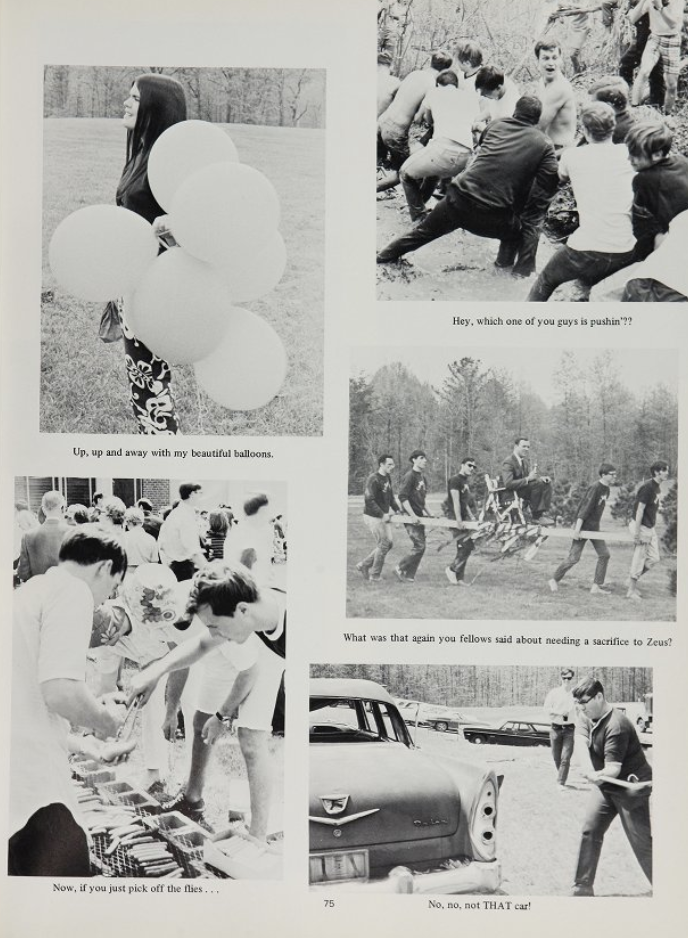
Figure 7. Yearbook page displaying various activities held on Mason day in 1968, including a dunk tank, smashing a car, tug-o-war and others. The Advocate, George Mason University Libraries Special Collections & Archives, George Mason University Yearbook Collection, Page 79, 1968.
One of Mason’s Day’s most interesting activities was the “week long camp out,” where students pitched their own tents and slept on campus.14 The 1978 Camp Out was advertised for “Lot K," which was located near a gym.15 The “camp out” was possibly a student response to not having dorms, but the tradition remained past when housing built on campus. The first camp out took place in the spring of 1969. As Mike Baker, BA English ‘70, described it: “I was the activities chairman from 1968-69, my junior year, so the first tents were in the spring of ‘69. We had them the next year, too. I said ‘Why not have dorms?’ and we put up tents all week, and we had campfires. Maybe 20 people camped out. We had local bands, a spaghetti dinner, dunking chambers, and the frats and sororities did different events.”16 This testimony came from 1969, while the first student housing was not built until 1978, which shows that student housing was debated for 10 years at Mason. By 1978, the university even provided porta johns for the campers’ convenience.17
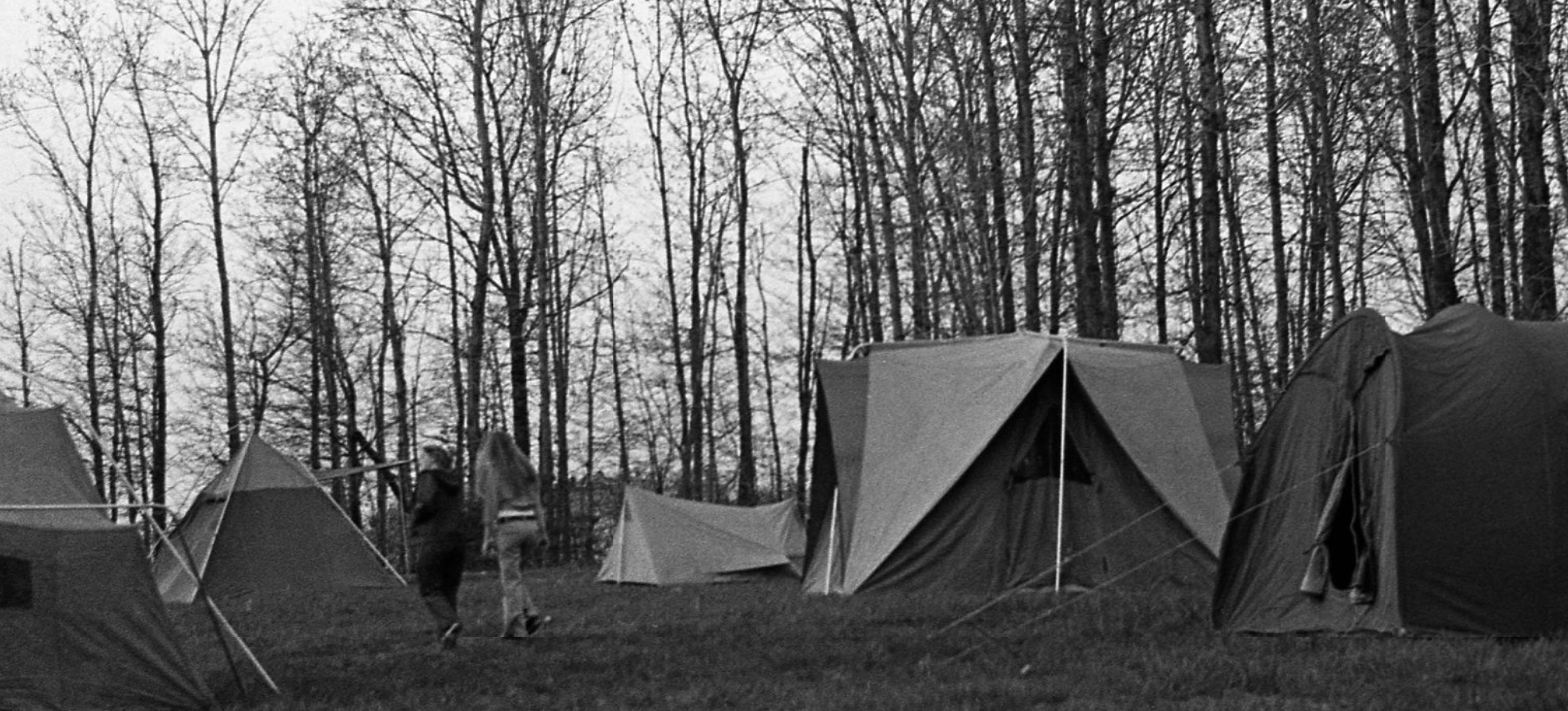
Figure 8. Tents set up for the 1975 Mason Day camp out. George Mason University Broadside Photograph Collection, George Mason University Libraries Special Collections & Archives, Box 8, Page 57, Frame, April 18, 1974.
Today, alcohol on campus is not legal for students under 21. Yet, surprisingly enough, alcohol was historically at the center of Mason Days and was given out for free on many occasions. Although, as Mike Baker attested, “The beer was 3.2 beer, not 6.4.”18 Records of the 1973 Mason Day show that Mason staff ordered specific permits in order for alcohol to be served.19 It was to be distributed in the middle of the quad, next to the SUB 1 building where the event was held. This beer was cheap, as many of the papers proclaimed. In the photos of Mason Day, many students were depicted consuming alcohol on campus. One of the beer companies sponsored Mason and the Broadside advertised Budweiser as the beer of choice, with an ad in 1983 that called it “the Mason Day Tradition.”20 This was the same year that the administration sold souvenir cups, perhaps for soda, but also beer. Nineteen eighty-eight was the last year beer was offered as a refreshment for students, as Virginia changed the legal drinking age from 18 to 21 and changed the legality of alcohol on campus for students.21
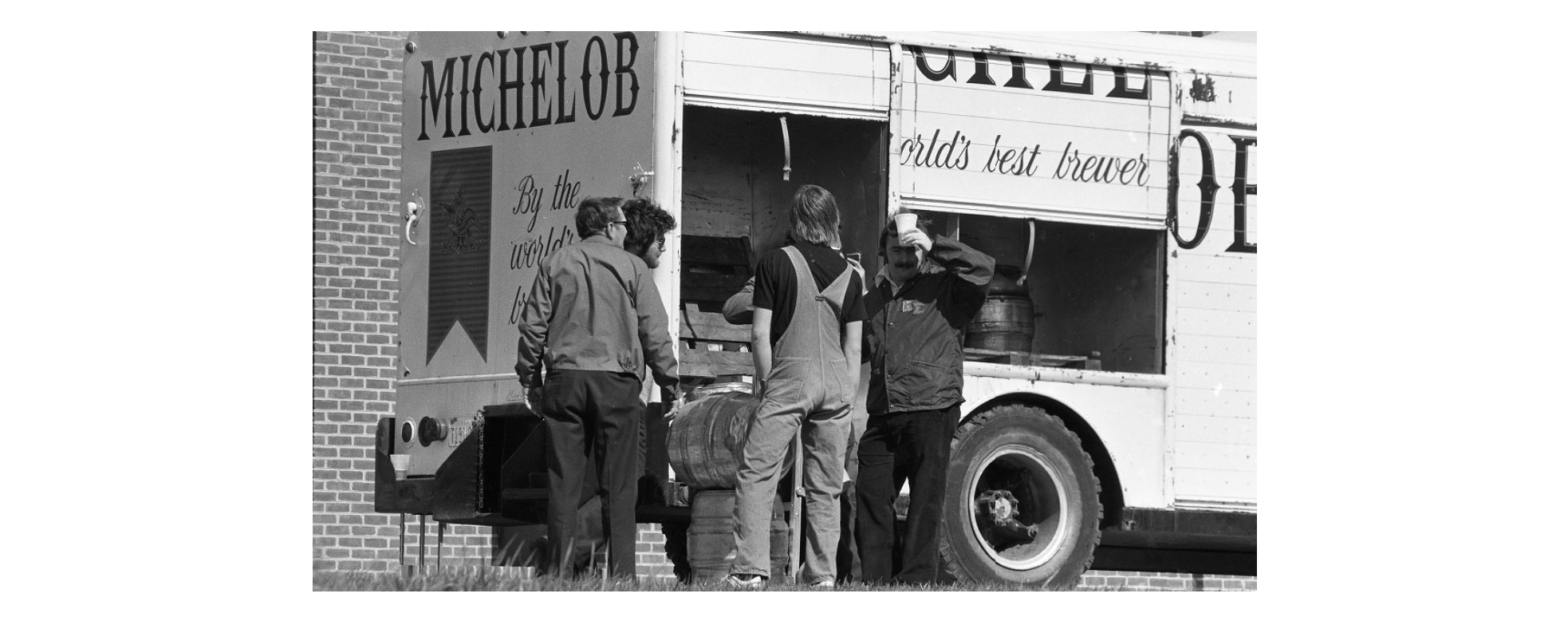
Figure 9. A Michelob beer truck at the 1974 Mason Day. George Mason University Broadside Photograph Collection, George Mason University Libraries Special Collections & Archives, Box 16, Page 86, Frame 31, April 14, 1978.
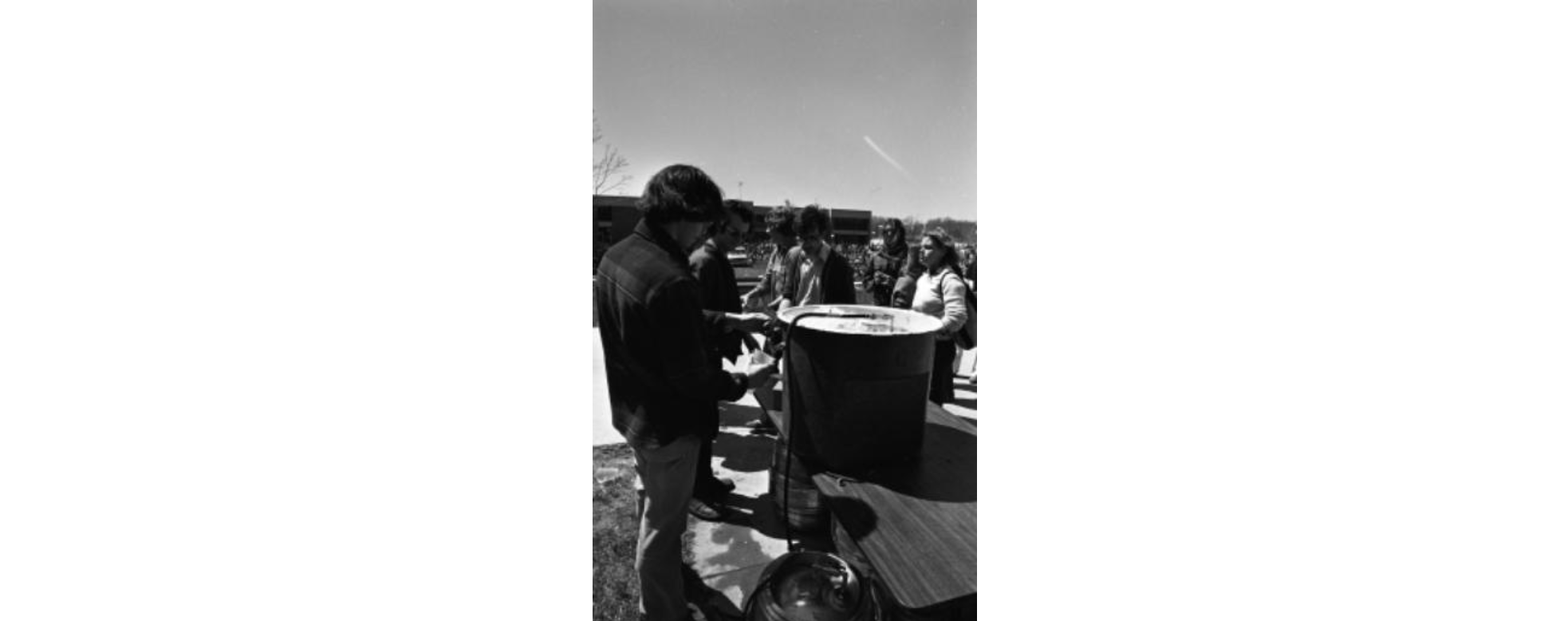
Figure 10. Men serving beers from a keg at Mason Day. George Mason University Broadside Photograph Collection, George Mason University Libraries Special Collections & Archives, Box 16, Page 85, Frame 15, April 14, 1978.
One event that seems to be consistent at every Mason Day is the concert held at the end of the event. While earlier Mason Days may not have hosted headliners or famous bands, there was always some sort of concert. The earlier Mason Days usually hosted smaller, local bands. Like Mason Day itself, as the event grew so did the popularity and fame of the bands. The most recent Mason Day in 2022 hosted Dominic Fike, a star from the popular TV show Euphoria.

Figure 11. Mason Day concert in 1998. George Mason University Broadside Photograph Collection, George Mason University Libraries Special Collections & Archives, Box 25, Page 117, Frame 29, April 14, 1998.
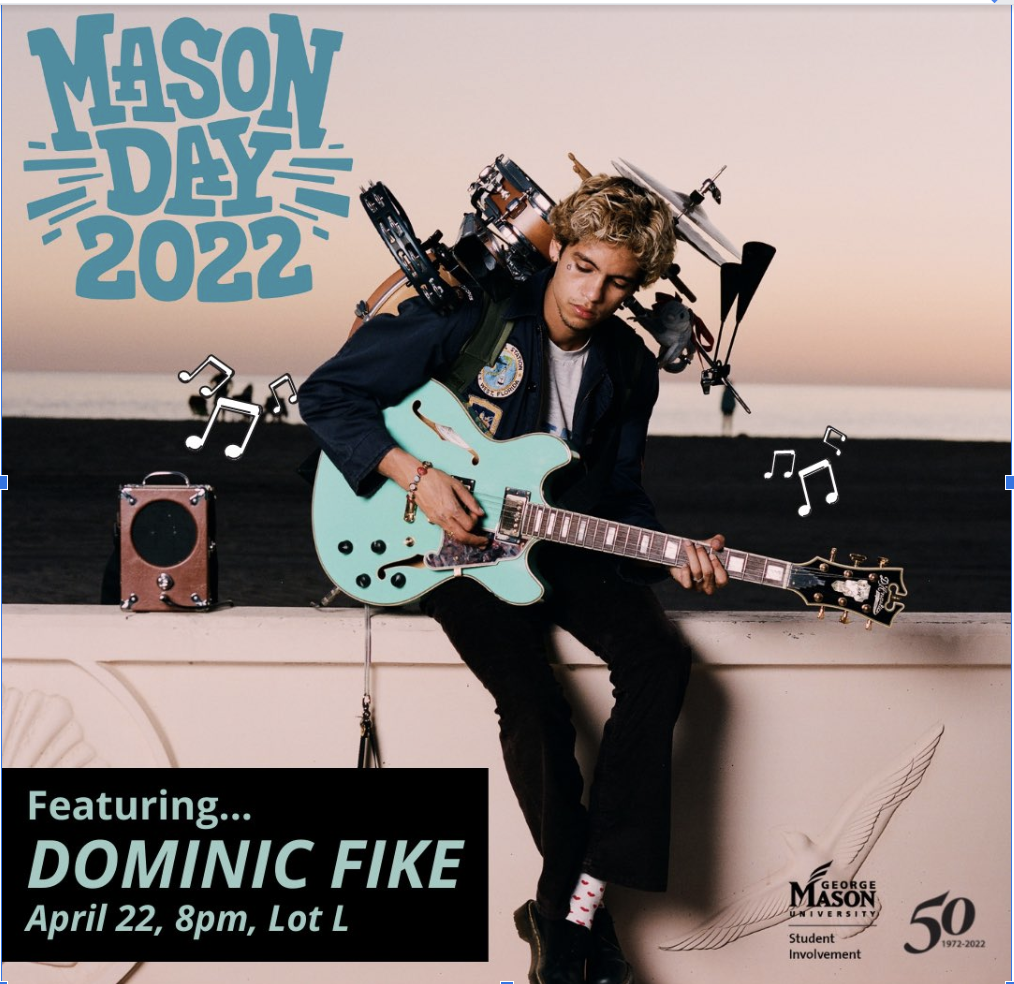
Figure 12. An ad for Mason Day 2022 featuring Dominic Fike.
Through the years, many events and traditions of Mason Day have come and gone. Nineteen-seventy marked the beginning of what President Thompson deemed the new traditions: a GMC flag, two flagpoles, music written by staff and beer sold with lunch. Even though those aspects no longer remain, Mason Day itself has become the University’s longest tradition and still holds the spirit of the original event. We still see the concert at the end of the night with dancing and celebrating. There are booths hosted by the student government and food, games, and activities. Students and staff alike come together and celebrate Mason on this day of events. So while the first traditions do not all remain, the heart and purpose of the event has held true. This is true in my personal experience, too. Even with the crowds and the lines at Mason Day, one can feel the connection to Mason and understand why it is Mason’s oldest tradition.

Figure 13. President Thompson’s Scrapbook showcasing the Firsts for Mason Day. President Thompson Scrapbook II, Mrs. Lorin Thompson, George Mason University Libraries Special Collections & Archives, Office of the President Records, Page 29, 1969 - 1971.
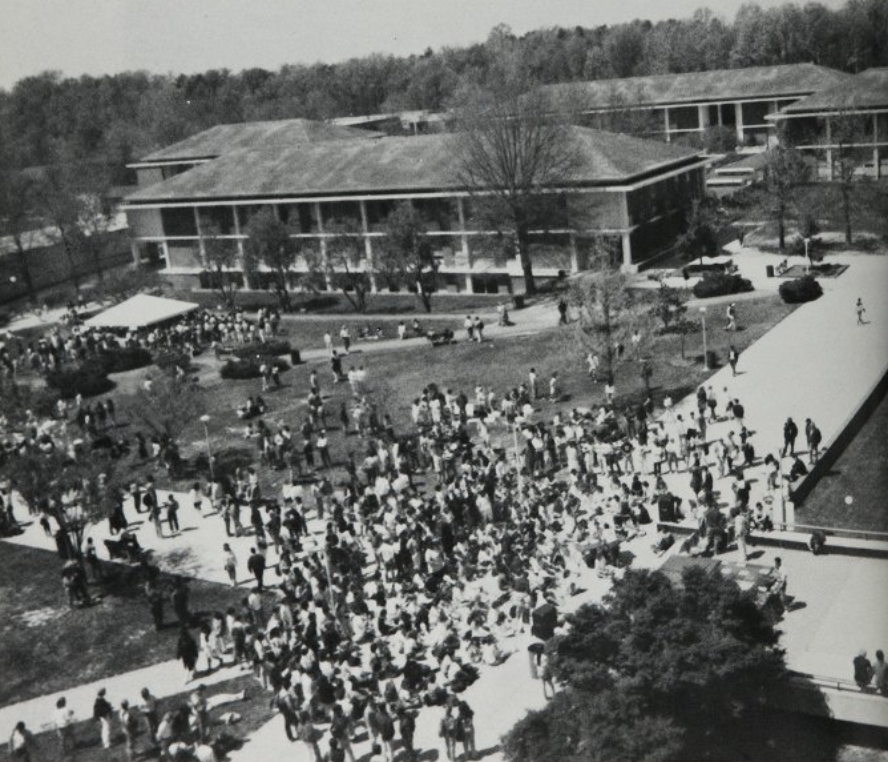
Figure 14. Aerial view of the Mason campus during the 1988 Mason Day. 1988 Yearbook, George Mason University Yearbook Collection, George Mason University Libraries Special Collections & Archives, Box 10, 1988.
Catalina Mayer is an undergraduate history major at George Mason University who will receive a Bachelor of Arts in History in the summer of 2022. She also studies communication and hopes to continue her education in law school or graduate school.
Suggested citation
Please use the following as a suggested citation:
Catalina Mayer, "Mason Day: George Mason's Longest Tradition," Mapping the University, Roy Rosenzweig Center for History and New Media, George Mason University (2022): <https://mappingtheuniversity.rrchnm.org/narratives/gmu-masonday/>.
“Mason Day Is Sunday at Gunston,” Northern Virginia Sun, Volume 32, Number 209, June 6, 1969. Accessed through the Virginia Chronicle, Library of Virginia. ↩︎
Buzz McClain ‘77, “50 Years of Mason Day: Tug-O-War, Bands, and a Greased Pig,” The Mason Spirit, November 2, 2015, accessed June 26, 2022. ↩︎
Colleen Kearney Rich, “Retro Mason: Mason Day,”], George Mason University, April 22, 2022. ↩︎
“George Mason Day,” Northern Virginia Sun, Volume 31, Number 175, April, 22 1968. ↩︎
Robert M. Collins, “The Economic Crisis of 1968 and the Waning of the ‘American Century.’” American Historical Review 101, no. 2 (1996): 396–422. ↩︎
Broadside Box 10, Vol. 18, No. 12, April 12, 1976. ↩︎
“Friday Festivities Slated for George Mason Day,” Northern Virginia Sun Volume 32, Number 209, 6 June 1969. Accessed through the Virginia Chronicle, Library of Virginia. ↩︎
Buzz McClain ‘77, “50 Years of Mason Day: Tug-O-War, Bands, and a Greased Pig,” The Mason Spirit, November 2, 2015, accessed June 26, 2022. ↩︎
“Friday Festivities Slated for George Mason Day,” Northern Virginia Sun Volume 32, Number 209, 6 June 1969. Accessed through the Virginia Chronicle, Library of Virginia. Gunston Ledger, Vol. 4, No. 20, April 21, 1967. Accessed on A History of George Mason, June 26, 2022. ↩︎
“George Mason Students Stage 1-Day Revolt,” Northern Virginia Sun, Volume 31, Number 174, 20 April 1968. Accessed through the Virginia Chronicle, Library of Virginia. ↩︎
“A University Celebrates,” Broadside Box 12, Page 1, April 17, 1978. ↩︎
Buzz McClain ‘77, “50 Years of Mason Day: Tug-O-War, Bands, and a Greased Pig,” The Mason Spirit, November 2, 2015, accessed June 26, 2022. ↩︎
“Mason Day 101,” Broadside, Box 17, April 18, 1983. ↩︎
“Friday Festivities Slated for George Mason Day,” Northern Virginia Sun Volume 32, Number 209, 6 June 1969. Accessed through the Virginia Chronicle, Library of Virginia. Gunston Ledger, Vol. 4, No. 20, April 21, 1967. Accessed on A History of George Mason, June 26, 2022. ↩︎
“SG Activities Visible,” Broadside Box 12, Page 1, February 20, 1978 ↩︎
Buzz McClain ‘77, “50 Years of Mason Day: Tug-O-War, Bands, and a Greased Pig,” The Mason Spirit, November 2, 2015, accessed June 26, 2022. ↩︎
“A University Celebrates,” Broadside Box 12, Page 1, April 17, 1978. ↩︎
Buzz McClain ‘77, “50 Years of Mason Day: Tug-O-War, Bands, and a Greased Pig,” The Mason Spirit, November 2, 2015, accessed June 26, 2022. ↩︎
Letter, George Mason University Libraries Special Collections & Archives, Office of the President Records (Lorin A. Thompson), Folder 8.8, April 5, 1973. ↩︎
Bud Light Advertisement, Broadside, Box 17, Page 7, April 18, 1983. ↩︎
Colleen Kearney Rich, “Retro Mason: Mason Day,”], George Mason University, April 22, 2022. ↩︎